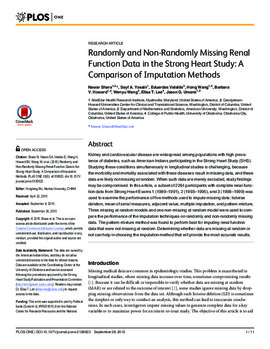| dc.contributor.author | Nawar Shara | |
| dc.contributor.author | Sayf A. Yassin | |
| dc.contributor.author | Eduardas Valaitis | |
| dc.contributor.author | Hong Wang | |
| dc.contributor.author | Barbara V. Howard | |
| dc.contributor.author | Wenyu Wang | |
| dc.contributor.author | Elisa T. Lee | |
| dc.contributor.author | Jason G. Umans | |
| dc.date.accessioned | 2017-03-05T22:55:18Z | |
| dc.date.available | 2017-03-05T22:55:18Z | |
| dc.date.issued | 2015-09-28 | |
| dc.identifier.citation | Shara N, Yassin SA, Valaitis E, Wang H, Howard BV, Wang W, et al. (2015) Randomly and Non-Randomly Missing Renal Function Data in the Strong Heart Study: A Comparison of Imputation Methods. PLoS ONE 10(9): e0138923. doi:10.1371/journal.pone.0138923 | en_US |
| dc.identifier.uri | https://hdl.handle.net/11244/49276 | |
| dc.description | We gratefully acknowledge Rachel Schaperow, MedStar Health Research Institute, for editing the manuscript.Disclaimer: The opinions expressed in this paper are those of the authors and do not necessarily reflect the views of the Indian Health Service. | en_US |
| dc.description | | en_US |
| dc.description.abstract | Kidney and cardiovascular disease are widespread among populations with high prevalence of diabetes, such as American Indians participating in the Strong Heart Study (SHS). Studying these conditions simultaneously in longitudinal studies is challenging, because the morbidity and mortality associated with these diseases result in missing data, and these data are likely not missing at random. When such data are merely excluded, study findings may be compromised. In this article, a subset of 2264 participants with complete renal function data from Strong Heart Exams 1 (1989–1991), 2 (1993–1995), and 3 (1998–1999) was used to examine the performance of five methods used to impute missing data: listwise deletion, mean of serial measures, adjacent value, multiple imputation, and pattern-mixture. Three missing at random models and one non-missing at random model were used to compare the performance of the imputation techniques on randomly and non-randomly missing data. The pattern-mixture method was found to perform best for imputing renal function data that were not missing at random. Determining whether data are missing at random or not can help in choosing the imputation method that will provide the most accurate results. | en_US |
| dc.language.iso | en_US | en_US |
| dc.publisher | PLos One | |
| dc.relation.ispartofseries | PLoS ONE 10(9): e0138923 | |
| dc.relation.uri | http://www.plosone.org/article/info%3Adoi%2F10.1371%2Fjournal.pone.0138923 | |
| dc.rights | Attribution 3.0 United States | |
| dc.rights.uri | https://creativecommons.org/licenses/by/3.0/us/ | |
| dc.subject | Cardiovascular diseases,Diabetes mellitus,Renal system,Algorithms,Kidneys,Heart,Health services research,Longitudinal studies | en_US |
| dc.title | Randomly and Non-Randomly Missing Renal Function Data in the Strong Heart Study: A Comparison of Imputation Methods | en_US |
| dc.type | Research Article | en_US |
| dc.description.peerreview | Yes | en_US |
| dc.description.peerreviewnotes | http://www.plosone.org/static/editorial#peer | en_US |
| dc.identifier.doi | 10.1371/journal.pone.0138923 | en_US |
| dc.rights.requestable | false | en_US |

